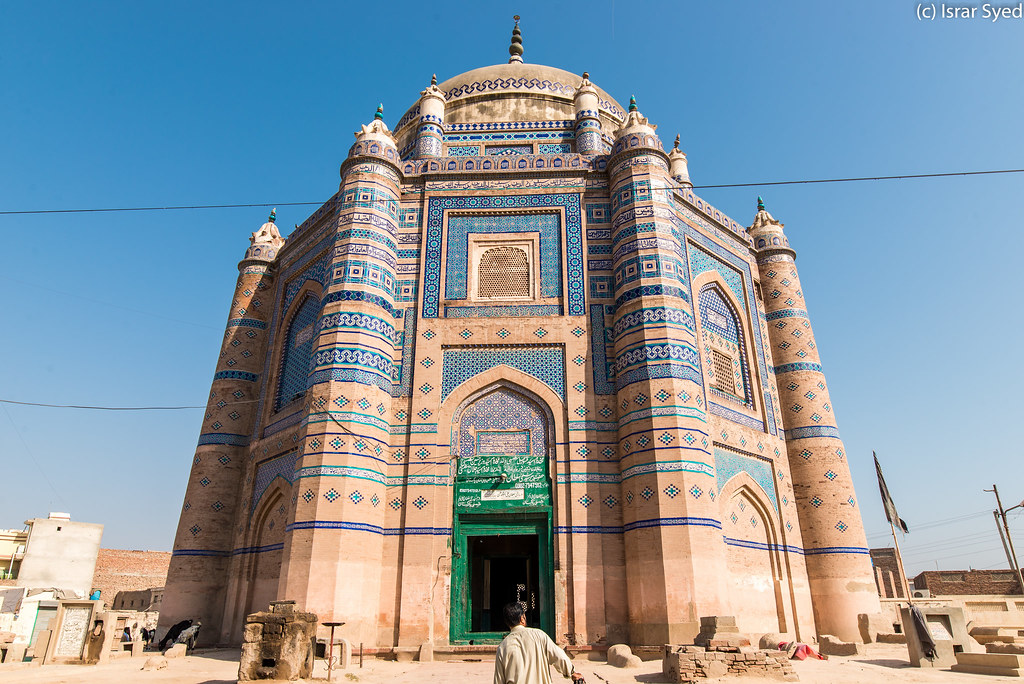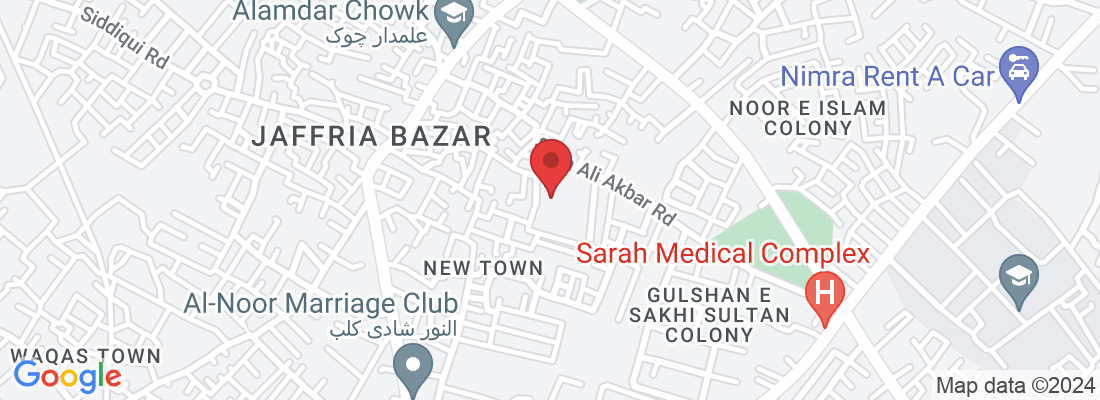MULTAN
City Of Saints
City Of Saints
Mausoleum of Shah Ali Akbar

Shah Ali Akbar, a significant historical figure in Multan, Pakistan, is renowned for his contributions to the region’s religious and architectural heritage. His tomb, located in Suraj Miani, Multan, stands as a testament to his legacy and the rich cultural history of the area.
Historical Background:
Shah Ali Akbar was a direct descendant of Shamsuddin Sabzwari, an early propagator of Isma’ili Islam in South Asia. His lineage and religious influence played a crucial role in the spread of Isma’ili teachings in the region. The mid-16th century marked the peak of his ministry, during which he garnered significant respect and following.
Architectural Significance:
The Tomb of Shah Ali Akbar, often referred to as the “little Rukn-e Alam,” is a masterpiece of Tughluq architecture. Built in 1585, the tomb shares many architectural elements with the nearby Rukn-e Alam mausoleum.Both structures feature battered walls, tapering turrets, and an octagonal layout capped with domes.The use of brickwork and wood as structural frameworks is a hallmark of the Tughluq style, which, despite the dynasty’s decline, continued to influence the architectural landscape of Multan and its surroundings.
Design and Construction:
The tomb stands on a 1.8-meter high square platform, measuring 30 meters in diameter. The octagonal plan is a distinctive feature, with three stories and tapering angle buttresses crowned by turrets.The walls are adorned with intricate brick designs and tile work, showcasing the craftsmanship of the period3.The architects, Ibrahim and Rajab, sons of Musa of Lahore, introduced the use of plaster for easily carvable surfaces, a trend that was gaining popularity in Mughal architecture at the time.
About Shah Ali Akbar:
ملتانی مٹی کا روشن چراغ
حضرت شاہ علی اکبر کا ہے عالیشان باغ
صوفیٔ کامل، محبت کا درس
آپ کے قدموں میں ملتا ہے ہر درد کا مرہم اور فرض۔
Interior and Decorations:
The interior of the tomb was originally decorated with high-quality murals and frescoes. Unfortunately, these artworks have suffered significant damage over the centuries due to exposure to the elements and pigeon droppings. Despite this, the remnants of the original decorations provide a glimpse into the artistic excellence of the era.
The use of plaster in the interior was a novel approach in Multan, reflecting contemporary architectural trends seen in other Mughal constructions like the Maryam Zamani mosque and Fatehpur Sikri.
Cultural and Religious Impact:
Shah Ali Akbar’s tomb is not just an architectural marvel but also a symbol of the religious and cultural history of Multan. His ministry and the construction of his tomb indicate a period of relative tolerance and acceptance of Isma’ili activities in the region. The personal wealth required to fund such a project suggests that Shah Ali Akbar enjoyed favorable relations with local authorities.
Preservation and Challenges:
Preserving the tomb of Shah Ali Akbar poses several challenges. The structure has endured centuries of wear and tear, and the damage to the interior decorations is a significant concern. Efforts to maintain and restore the tomb are crucial to preserving this important piece of cultural heritage.The tomb’s historical and architectural significance makes it a valuable site for both scholars and tourists.
Short Words:
The Tomb of Shah Ali Akbar in Multan is a remarkable example of Tughluq architecture and a testament to the rich cultural and religious history of the region. Its unique design, historical significance, and the challenges it faces in preservation highlight the importance of maintaining such heritage sites. Shah Ali Akbar’s legacy continues to be remembered and celebrated through this architectural gem, which stands as a symbol of Multan’s historical and cultural identity.
Who was Shah Ali Akbar?
Shah Ali Akbar was a direct descendant of Shamsuddin Sabzwari, an early propagator of Isma’ili Islam in South Asia. He was active in the mid-16th century and is known for his contributions to the spread of Isma’ili Islam in the region.
Where is the tomb of Shah Ali Akbar located?
The tomb of Shah Ali Akbar is located in Suraj Miani, Multan, in the Punjab province of Pakistan.
When was the tomb of Shah Ali Akbar built?
The tomb was built in 1585. Oral traditions suggest that Shah Ali Akbar personally funded the construction of his tomb, indicating his significant personal wealth and favorable relations with local authorities.
What is the architectural style of the tomb?
The tomb is often referred to as the “little Rukn-e Alam” due to its architectural similarities with the nearby Rukn-e Alam mausoleum. It features elements of the Tughluq style, such as battered walls, tapering turrets, and an octagonal layout with domes.
What materials were used in the construction of the tomb?
The tomb extensively used plaster for its interior surfaces, a trend introduced by Mughal architects during the reign of the third Mughal emperor, Akbar. The plaster surfaces were originally adorned with high-quality murals and frescoes.
6. Are there any unique features of the tomb?
Yes, the tomb has four inward-facing alcoves along the second story, which is a curious feature of its design. Unfortunately, many of the original murals and frescoes have suffered significant damage over time.
Is the tomb of Shah Ali Akbar a popular tourist attraction?
Yes, the tomb is a notable historical and architectural site in Multan and attracts visitors interested in the region’s rich cultural heritage.
Who was Shah Ali Akbar?
Shah Ali Akbar was a direct descendant of Shamsuddin Sabzwari, an early propagator of Isma’ili Islam in South Asia. He was active in the mid-16th century and is known for his contributions to the spread of Isma’ili Islam in the region.
Where is the tomb of Shah Ali Akbar located?
The tomb of Shah Ali Akbar is located in Suraj Miani, Multan, in the Punjab province of Pakistan.
When was the tomb of Shah Ali Akbar built?
The tomb was built in 1585. Oral traditions suggest that Shah Ali Akbar personally funded the construction of his tomb, indicating his significant personal wealth and favorable relations with local authorities.
What is the architectural style of the tomb?
The tomb is often referred to as the “little Rukn-e Alam” due to its architectural similarities with the nearby Rukn-e Alam mausoleum. It features elements of the Tughluq style, such as battered walls, tapering turrets, and an octagonal layout with domes.
What materials were used in the construction of the tomb?
The tomb extensively used plaster for its interior surfaces, a trend introduced by Mughal architects during the reign of the third Mughal emperor, Akbar. The plaster surfaces were originally adorned with high-quality murals and frescoes.
6. Are there any unique features of the tomb?
Yes, the tomb has four inward-facing alcoves along the second story, which is a curious feature of its design. Unfortunately, many of the original murals and frescoes have suffered significant damage over time.
Is the tomb of Shah Ali Akbar a popular tourist attraction?
Yes, the tomb is a notable historical and architectural site in Multan and attracts visitors interested in the region’s rich cultural heritage.
We use cookies to ensure that we give you the best experience on our website.
© Copyright Multan 2024


Facebook
LinkedIn